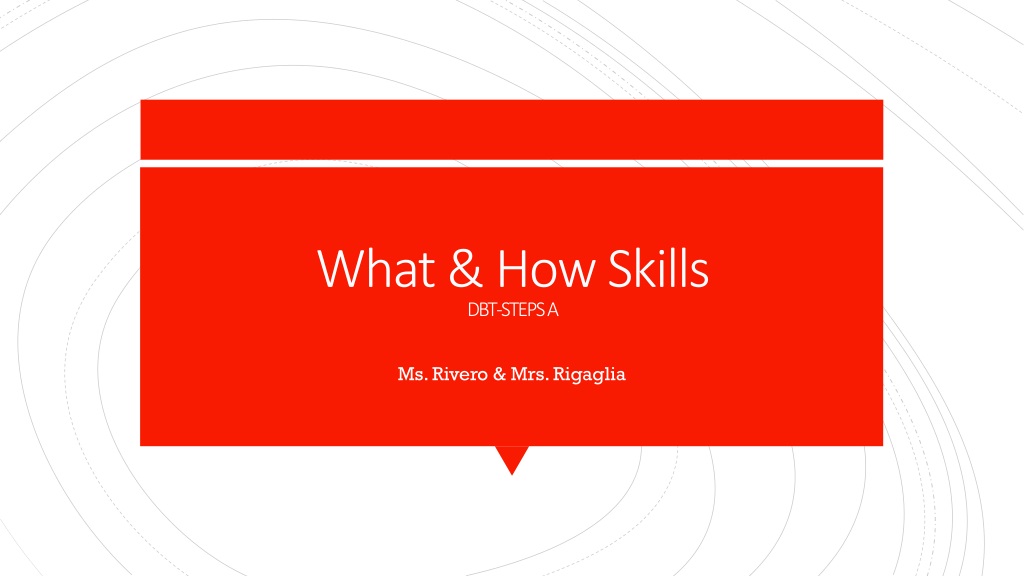

0 likes | 19 Vues
Learn the essential "what skills" and "how skills" in Dialectical Behavior Therapy (DBT) to achieve Wise Mind. Explore the mindfulness "what skills" of observe, describe, and participate, along with the corresponding "how skills" of nonjudgmentally, one-mindfully, and effectively. Understand the importance of observing inside and outside, describing experiences, and fully participating in the present moment to balance emotional and reasonable minds towards wise decision-making.

E N D
What & How Skills DBT-STEPS A Ms. Rivero & Mrs. Rigaglia
What and How What and How (Lesson 4 & 5) (Lesson 4 & 5) There are 3 mindfulness "what skills," which are what we do and 3mindfulness "how skills," which are how we do them
Quick Review.... Quick Review.... Emotion Mind: What I feel to be Reasonable Mind: What I think to be Wisemind: What I know to be *The what & how skills = get us to wisemind*
The 3 mindfulness What skills are:observe,describe,and participate.You can only do one of these at a time.These are what we do in order to reach wise mind and be mindful. Paying attention on purpose, without reacting What Skills What Skills Noticing without labeling Process of focusing the mind on one thing – what you sense or experience Wordless watching - just watching Being able to control your attention, means that you can control your mind. Most important, it is about observing what reality is, not what we think about reality. Handout 4.1
Mindfulness: What Skills Mindfulness: What Skills https://youtu.be/JUSaQL1_zXE
Observing Inside vs. Observing Outside Observing Inside vs. Observing Outside Observing Outside We can only observe the outside world through our five senses: seeing, hearing, smelling, tasting, and touching. Observing inside Observe our inside worlds through sensing our thoughts, emotions, and internal bodily sensations We notice & watch them pass even when they are painful We don’t want to avoid or suppress the thoughts & emotions we are observing
Observing Without Describing Observing Without Describing It can be hard to observe something without describing it The same way we hear "meow" and think of a cat You cannot observe & describe at the same time
Describing Describing - Putting what you have observed into words. Describing is labeling what is observed; it is wordful watching - Mindfulness is about slowing down and doing just one thing at a time. Describing is labeling what we have observed, as if explaining it to a blind person or to an artist who is going to draw on the basis of our description. We can ONLY describe something if we observed it. We cannot observe the thoughts, feelings, or intentions that are inside other people.This is a key point that we often forget. *Activity of hands on desk
Participating Participating Participating is being fully present to our own lives, without self- consciousness, effortlessly in flow – forgetting ourselves and becoming what we are doing. Watch young children. Whether they are running through a park, splashing in puddles, or dancing to music, children are great examples of participating. (handout 4.1) Participating is not thinking about yesterday or tomorrow. It is not worrying about what other people are thinking or feeling about us right now. It is about jumping in the current activity 100%.
Now that we have gone over "What Skills" we are going to learn "How Skills": are for balancing emotional mind and reasonable mind to achieve wise mind. Just as there are 3 "What skills" there are 3 "How Skills" How How Skills Skills * nonjudgementally, one-mindfully, and effectively. Unlike what skills which can only be done one at a time the how skills can all be done at the same time.
Mindfulness: How Skills Mindfulness: How Skills https://youtu.be/oYdrMpnE93s Handout 5.1
NONJUDGEMENTALLY NONJUDGEMENTALLY The way to observe, describe, or participate mindfully is to take a nonjudgemental stance. In other words do not judge anything as good or bad, as valuable or not valuable, as worthwhile or worthless, as how things should or should not be. Judgements can act as fuel for our emotions
(handout 5.1) One-mindfully means doing only one thing at a time, in the moment, with awareness and alertness. It is about the quality of awareness. Focusing attention on only one thing helps bring the whole person to the activity without expectations. It means focusing on what is immediately present, and not the past or the future. ONE ONE- - MINDFULLY MINDFULLY Ways it can be harmful Some behaviors can function together as a set (notes & class time)
(handout 5.1) When do throw yourself 100% into an activity. Doing something effectively means knowing your goals, objectives, and actual situation. Giving your all to the best of your ability Asking yourself, "Is this aligned with my long-term goals?" EFFECTIVELY EFFECTIVELY Not letting emotions drive behavior ** To be effective is to do what works to reach our goals. Once we can identify our objectives, then we can begin to determine the most effective route to obtaining them